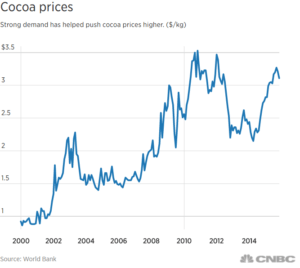Mars’ Reponse to Chocolate’s Sticky Situation

It’s hard to imagine Halloween without its essential ingredients- chocolate and candy. But climate change is a major threat to future generations of trick or treaters. Leading the charge to save chocolate is Mars Inc., the world's largest candy manufacturer.
Global demand for chocolate has been rising steadily, in part due to increasing demand from emerging markets. The global chocolate market rose 13 percent from 2010 hit $101 billion in sales in 2015.[1] But climate change is threatening the world’s supply of chocolate, leading to projections supply will soon be unable to meet chocolate demand.
Mars’ Sticky Situation
One company is already on a mission to save chocolate – Mars Inc., a $33B company food and candy manufacturer (it produces snickers, M&Ms, and more). As the worldwide largest candy producer, and one of the world’s largest purchasers of cocoa, it’s particularly concerned about climate change. The cacao tree only grows in certain temperatures and is very sensitive to natural fluctuations – it is estimated that only 10% of the world’s potential cocoa production is realized each year. All of the cocoa produced in the world is grown within 20 degrees of the equator, with 70% from West Africa alone. However, rising temperatures and unpredictable rainfall patterns will dramatically change where coca can be farmed. Some areas in West Africa will become completely unsuitable for cocoa by 2030, while others will only remain suitable after farmer adaptation.[2]
Not only is climate change threatening Mars’ supply chain, but it already affecting its bottom line. Cocoa demand has already started to outpace cocoa supply, sending cocoa prices up significantly over the past 15 years.[3]
Mars’ Green Thumb
Mars has undertaken significant steps in response to the threat of climate change. First, Mars has taken a considerable interest in protecting its farmers, who face the losses of their livelihoods due to climate change. Mars partnered with other major industry players like Nestle and Hershey to form CocoaAction, which helps farmers learn and implement sustainable farming practices while also providing better cocoa trees, fertilizer and training.[4] Mars also committed to buying 100% of its cocoa from certified sustainable farmers by 2020.[5]

Mars is also focused on reducing its own contributions to climate change. In 2015 Mars cut its greenhouse gas (GHG) emissions by 25% and has pledged to eliminate all GHG emissions from its operations by 2040. To achieve this reduction, Mars has instituted a number of energy saving initiatives worldwide, including a sizable investment in a wind farm in Texas to generate 100% of the electricity it uses in the US. The U.S Environmental Protection Agency (EPA) ranked Mars as the 6th largest user of green power in the US in 2015. [6]
To manage existing weather and climate change impacts, Mars employs meteorologists who study weather patterns that may impact Mars’ supply chain, and use their research to help Mars adapt its supply chain and sourcing to events like storms if needed.[7]
What’s Needed Next
Though Mars’s renewable energy use and farmer assistance is incredibly beneficial, it should also increase its partnerships with the scientific community to focus on cacao trees and beans directly. Mars has done some scientific investment through its launch the Cacao Genome Project in 2008, through which it released the genome free online so that breeders could identify traits of climate change adaptability[8]. However, to make cacao trees more resilient, Mars should increase its investments in scientific research to create greater genetic diversity among trees. For example, scientists developed a new strain of cacao tree, CCN51, that is resistant to disease and produces seven times more beans than a traditional tree. However, the strain is virtually unusable as its flavor profile is far inferior to traditional cocoa.[9] Mars should invest in scientific efforts to work on creating cacao tree strains that are adaptable to climate change while maintaining their original flavor profiles.
In addition to scientific investments, Mars should leverage its previous success in uniting private and public players to assist other companies in adopting its green energy initiatives. Even if Mars achieves its goal of carbon neutrality by 2040, its efforts will not be enough to offset increased energy consumption by the rest of the world. Mars should provide free training and resources to companies in other industries to encourage them to reduce their GHG emissions. Together with the support of public governments, the scientific community, and other private industries, Mars has the power to save chocolate from climate change.
(726 words)
[1] Katy Barnato and Luke Graham, “Future of the chocolate industry looks sticky,” CNBC, March 24, 2016, http://www.cnbc.com/2016/03/24/future-of-the-chocolate-industry-looks-sticky.html, accessed November 2016.
[2] Katherine Dunn, “Cocoa Production Could Be Devastated by Climate Change, Experts Warn,” The Wall Street Journal, September 15, 2016, http://www.wsj.com/articles/cocoa-production-could-be-devastated-by-climate-change-experts-warn-1473952130, accessed November 2016.
[3] John Schoen, “Why are chocolate prices jumping?” CNBC, February 13, 2015, http://www.cnbc.com/2015/02/13/why-are-chocolate-prices-jumping.html, accessed November 2016.
[4] CocoaAction, 2015 Annual Report
[5] Mars Incorporated, “Our Cocoa Policy,” http://www.marsgcc.com/global/about-us/policies-and-practices/cocoa-policy, accessed November 2016.
[6] Mars Incorporated, “Mars catapults to #6 on list of biggest green power users,” http://www.mars.com/global/press-center/newsroom/-mars-catapults-to-6-on-list-of-biggest-green-power-users, accessed November 2016.
[7] Kate Taylor, “The smart reason the world’s largest candy maker is hiring meteorologists,” Business Insider, September 28, 2016, http://www.businessinsider.com/mars-chocolate-hires-meteorologists-to-deal-with-climate-change-2016-9, accessed November 2016.
[8] Mars Incorporated, “Environment,” http://www.marsgcc.com/global/science-and-innovation/science/environment, accessed November 2016.
[9] Mark Schatzker, “To Save Chocolate, Scientists Develop New Breeds of Cacao,” Bloomberg, November 14, 2014, http://www.bloomberg.com/news/articles/2014-11-14/to-save-chocolate-scientists-develop-new-breeds-of-cacao, accessed November 2016.




Rachel,
Very interesting post. I found it interesting and great that Mars was able to partner with Hershey and Nestle to create CocoaAction. Later in the post you mentioned Mars should again use it’s global brand to help spread awareness and their technologies to additional businesses in order to maximize overall global sustainability. I saw this as a possibility for Anheiser Busch (the company I wrote about) as they are also an industry leader in both manufacturing beer, but also in their “green” initiatives. What is you take on how these large companies can balance teaching others better ways of being sustainable while also maintaining a competitive advantage? As discussed in TOM during the IKEA case, the majority of these sustainable advantages also tend to drive profitability, so it is difficult to be optimistic that these sharings will always happen.
Interesting, I had no idea 70% of cocoa came from West Africa. If I were mars I would also look at how I could diversify my supplier base away from west africa to other regions that may be less impacted by climate change. I also wonder if they could find suppliers who grow the beans in climate controlled (i.e. greenhouse conditions). Mars should also diversify away from chocolate products to reduce their exposure to the availability and price of cocoa raw materials